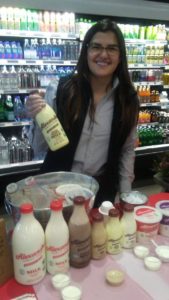FARM TO FORK COLUMN
By: Victor Martino
Regenerative Ag – A Back to the Future Technique for Farming
Chico State University in Chico has launched the Initiative for Regenerative Agriculture, a major research and practical farming initiative staffed by a “working group of multi-disciplinary faculty who’ve come together to develop collaborative research and teaching strategies for the primary purpose of drawing down legacy levels of greenhouse gas emissions through carbon sequestration and ecosystem service restoration.”
The leaders of the initiative, which is housed at the university’s Institute of Sustainable Development, say the science-based effort “will have far reaching implications across disciplines in areas of climate and food policy, agricultural husbandry practices, food justice, agribusiness models and local food sheds.”
The researchers and other allied with the program, including farmers, plan to spur the creation of an educational focus investigating agriculture that restores climate stability from a transdisciplinary perspective and ultimately to share best practices from the initiative’s research efforts with society and the broader agricultural community, according to their mission statement.
The initiative’s founders, which include farmers like Central Valley-based Burroughs Family Farms, define regenerative agriculture as an “approach to food and farming systems that work with nature’s rhythms and technology to feed our growing population, regenerate topsoil and enhance biodiversity now and long into the future.”
I talked with Rosie Burroughs this week, who with her husband and children farm in Merced County, about the regenerative agriculture initiative. She’s a founding-member and has provided financial support to get the program launched at Chico State.
Burrough’s Family Farms grow organically, along with operating a grass-fed -based organic dairy.
The Burroughs also take a vertically-integrated approach to farming. In addition to selling their crops in bulk, they develop, market and sell a host of branded food products and their own brand of organic milk to grocery stores throughout California and elsewhere.
They also grow almonds and olives (for their olive own brand of olive oil), other crops, and raise beef, chickens and goats, along with making and selling their own brand of cheese. A highly diversified farming operation.
Because they use regenerative agriculture methods, Burroughs Family Farms is able to obtain a premium for the value-added branded products they produce and sell directly to consumers and to retailers.
Rosie Burroughs told me her guiding philosophy in farming is, “All life starts with the soil, and healthy soil equals healthy plants, which help make for healthy people and a healthier planet.” She’s no hippy either.
This philosophy, which guides how the family farms, was behind her decision to help fund and participate in the new regenerative agriculture initiative at Chico State University.
One of the practices the family uses isn’t new at all. In fact, you might call it “Back to the Future Farming.” It’s the use of cover crops like grasses, legumes, mustard and the like as a regular practice to maintain healthier soil.
Some may argue such a practice is too labor intensive for many farmers. However, it is making a comeback throughout farming, and not just in California.
Another farmer employing the cover crop practice is Joe Del Bosque, who owned and operates Del Bosque Farms in Merced County, and who I wrote about in my column last month. He’s based out of Los Banos and
operates a farm with a diverse array of crops, including almonds, cherries, melons and asparagus. Del Bosque farms both conventionally and organic.
Rosie Burroughs says she’s discovered that “mimicking Mother Nature” in farming can pay dividends because, after all she says, “Mother Nature is perfect.”
Regenerative agriculture is also getting a boost from big U.S. food companies like General Mills and Kelloggs, who’ve both moved into the organic foods category in a big way.
For example, General Mills just purchased a substantial amount of conventional grain acerage in South Dakota that it plans to convert to organic, using regenerative farming practices. General Mills will fund the effort, having the farmers continue to operate the farms.
General Mills plans to use the organic grains for its popular Annie’s Homegrown brand of boxed macaroni and cheese and other branded products sold in grocery stores.
Kelloggs, which owns the popular Kashi organic brand, is also investing in regenerative agriculture research and moving into developing a practicle scenario similar to what General Mills is doing.
Other food companies large and small are introducing branded products using a new “Regenerative Agriculture” seal recently developed by the Rodale Institute. Like has been the case with organic, the branded products are expected to create a demand for foods grown this way, encouraging more farmers to adopt regenerative ag practices.
The Chico State University initiative will assist farmers in Northern California who want to move into regenerative agriculture. The vibrant entrepreneurial food movement in the region is also behind the initiative.
For example, rice-grower and branded food company Lundberg Family Farms near Chico has already introduced some branded rice products under the regenerative agriculture banner.
Creating consumer demand for such products is key to providing an incentive to farmers, like with organic, to experiment with regenerative ag methods and convert cropland to the practice.
Rosie Burroughs described to me her journey in farming over many decades. “I was taught conventional farming. But as a mother nurturing and protecting my children, I wanted to provide the best quality food I could for them. I started connecting nutrition, food and farming. Organic and regenerative farming was the logical choice for me. It’s also more sustainable.”
She adds she’s also found it more economically viable over time because higher-production conventional farming comes with a higher cost of production with less margin.
You will be hearing a lot more about regenerative agriculture in the next couple years, along with seeing more branded food products on grocery stores carrying the regenerative agriculture seal.
Farmers interested in learning more can contact the Institute for Sustainable Development at Chico State University.
The farm and America’s plant-based foods revolution
One of the glaring realities of our food and farm system is the fact that food companies and retailers seldom talk with farmers and vice-versa. This is sad because farming and the food industry are in reality part of the very same system; intertwined. It’s called the supply chain — from farm to grocery store shelf and ultimately to your fork.
The downside of this lack of communication is that grocery retailers and food makers spot trend that can be of significant help to farmers. For example, grocers and the dairy foods industry have know for many years that plant-based food and beverage products have been growing like crazy, primarily to the detriment of dairy and some animal-based foods. The meteoric growth of almond milk over the last 20 years is a perfect example of the plant-based food and drinks revolution.
Part of my mission with the Farm To Fork column is to try to bridge this communications gap. In my opinion, food makers and retailers and farmers need to meet both formally and informally and talk to one another. Farmers can learn much from those at the other end of the food supply chain and the food industry can learn much from farmers.
The plant-based boom: According to respected food and grocery industry research firm Nielsen, as of 2017 the plant-based food and drink channel products channel in the U.S. is at around $3.1 billion in annual sales, with year-over-year (end of August 2016 to end of August 2017) sales growth of 8.1%. In contrast, the overall food market grew during the same period by 2%.
Some categories within the segment, like plant-based yogurt (56% growth during this period), are growing at such a high percentage rate that grocery retailers are scrambling for shelf space for all the new brands and SKUs hitting the market.
Sales of almond milk have grown 250% over the last 5 years alone.

The boom in plant-based alternative dairy products is a major reason fir the decline in animal dairy milk and value-added dairy products, and the struggles many dairy farmers are experiencing.
Sustained growth: Research firm Health Focus International recently found that 17% of U.S. consumers aged 15 to 70 claim to eat a predominantly plant-based diet, while 60% said they are cutting down significantly on meat-based products. Of those who are reducing their intake of animal-based proteins, 55% say the change is permanent, and 22% say they hope it to be permanent.
The hottest new growth area in the plant-based foods world is plant-based meat products, like the Beyond Burger. Beyond Meat, the company that produces the faux hamburger, has raised hundreds of millions of dollars in just a couple years and has the product – it just launched a new plant-based sausage – in big grocery chains like Whole Foods, Costco, Kroger, Albertsons/Safeway and others. Giant foodservice distributor Sysco is distributing Beyond Burger to restaurants throughout the U.S.
The faux meat appears to be selling well, winning positive comments frim executives of the grocery giants mentioned above.
This trend is important to farmers because it can serve as valuable decision-making data. For example, farmers in California’s Central Valley might want to consider replacing some or all if their low-profit feed corn acreage with higher margin crops in demand.
Dairy farmers might want to diversify, perhaps adding almond acreage if they have or can obtain the land. Sales of almond milk and value-added products like yogurt and ice cream are forecast to grow by 7 to 10% over the next decade. In contrast, sales of dairy milk and value-added dairy products, with the exception of yogurt, are projected to have flat or negative sales growth over the same upcoming decade.
Dairy farmers might want to diversify…
Reinventing Dairy update
In my February column of the same name, I called for dairy farmers who are able to take a new approach.
 Last week I met up with Savannah Alexandre of Cresent City-based
Last week I met up with Savannah Alexandre of Cresent City-based
Alexandre Family Farms, at The Market specialty supermarket on Market Street in San Francisco.
Savannah, the youngest member of the family business, was sampling their new branded line of value-added organic milk (the flavor in her hand in the photo is Ginger-Turmeric).
Alexandre Family Farms is getting it’s milk placed in higher-end grocery stores all over California. The milk, which harkens back to good old cream top varieties of the past, is delicious. It was a huge hit with the city folk, as well as tourists, at the store last week.
Entrepreneurial dairy farmers like Savannah’s family and others noted in my February column are taking things into their own hands and “reinventing dairy.”
By: Victor Martino (Writer & Analyst)
Email: VictorMartino415@gmail.com
Twitter: NSFoodsMemo

Victor Martino, Ag Expo Magazine’s new columnist, writer and analyst, is founder and president of San Francisco and Modesto-based Third Wave Strategies, a strategic marketing, business development and communications firm specializing in the food, grocery and ag industries. He’s also a columnist and writer for the global food industry publication just-food, a food industry analyst, and an entrepreneur. Martino was born and raised in the Central Valley. Contact: victormartino415@gmail.com. Twitter: www.twitter.com/nsfoodsmemo
